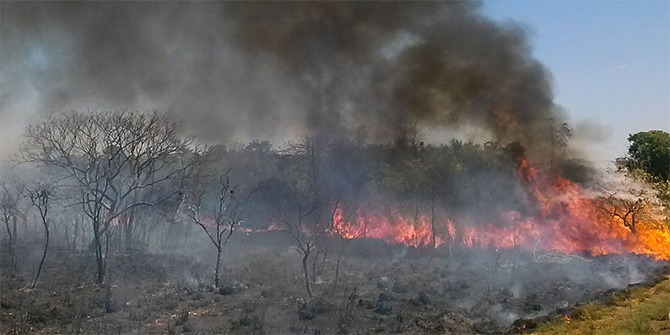Conservative movements using disinformation tools were not a mere occurrence in the 2018 election. As Jéssica da Silva Duarte (Federal University of Pernambuco, Brazil) found, the current Brazilian campaign has been flooded with messages pointing at beliefs and values to distort voters.
The 2018 presidential election was a milestone in Brazil’s political history. First, it was the country’s first election in which the Internet and digital media were established as an absolute space for political activism and means of communication. And in this context, it was also an election strongly marked by the dissemination of false and incorrect information in these media. Precisely these changes favoured the action of think tanks and influencers for the growth of the so-called “conservative wave” and the consequent election of Jair Bolsonaro. Until then, the current president had no political expressiveness and was representative of a party acronym without tradition. He only had eight seconds of television in the Free Electoral Broadcast Airtime (HGPE).
When used in a systematic way, disinformation ends up emptying the political agenda, imposing in its place a news cycle based on accusations, conspiracy theories and successive need for clarifications. This fact could be clearly observed in a recent debate in September broadcasted by Rede Globo. We need to pay attention to these facts because information and critical capacity are fundamental aspects of the democratic debate.
It is almost inevitable to question whether these same groups and strategies are relevant again in the 2022 elections. Disinformation includes not only fake news but also conspiracy theories and distortion of facts. In this tactic that turns lies into a communication tool, facts are distorted or invented to mobilize public opinion based on their emotions and beliefs. Another characteristic of the current disinformation model is its adaptation to the communication mode of social media, in which there is a combination of false political arguments and entertainment.
Social media growth
This format has been very effective in Brazil, in 2016 the number of people using social media as an information source in the country was estimated at 72%. In another report done by Lupa Agency in partnership with the Universities of São Paulo and Minas Gerais (USP and UFMG), it was identified that among the fifty 14 images with the largest circulation in WhatsApp groups, only four were true;. In contrast, the others consisted of disinformation with the intention of influencing the electorate. Due to this context, a set of organizations known as fact checkers were created in order to mitigate the impact of misinformation, such as: Agência Lupa, Aos Fatos, Boatos.org, Comprova, E-Farsas, Fato ou Fake and even Bolsonômetro from Folha de São Paulo.
This format has been very effective in Brazil. In 2016, the number of people using social media as an information source in the country was estimated at 72%. In another report by Lupa Agency in partnership with the Universities of São Paulo and Minas Gerais (USP and UFMG), it was identified that among the fifty 14 images with the largest circulation in WhatsApp groups, only four were true. In contrast, the others consisted of disinformation intending to influence the electorate. In this context, a set of fact checking organisations were created to mitigate the impact of misinformation, such as Agência Lupa, Aos Fatos, Boatos.org, Comprova, E-Farsas, Fato ou Fake and even Bolsonômetro from Folha de São Paulo.
With that same intention, the Superior Electoral Court (TSE) has sought to make agreements with the companies with the largest number of users in the country. However, these arrangements are vague and not very effective. On the one hand, there is not a unified document for all applications. Still, there is one point in common among them and it is not optimistic: platforms have no accountability if their ad services are used to spread disinformation.
Moreover, the decision-makers on what should or should not be deleted or punished are exclusively the companies. The TSE has no power over this beyond the ability to make complaints. Finally, the communication process between the platforms and the Court is not simple and fast. In the best-case scenario, when disinformation is removed from the Internet, the content has been tent accessible long enough to reach many people.
Content going viral through social media serves the interests of political elites because it mobilises their supporters. These messages are usually directed in favour of or against political groups, and are particularly effective in activating political identities and making people more oriented towards political goals. The increasing dispersion of information has made it very difficult to find facts, making people increasingly confused and susceptible to versions of reality constructed from specific interests. In Brazil, conservative groups have mainly used and absorbed these tools. According to a study by Avaaz, 98% of Jair Bolsonaro’s voters in 2018 were exposed to fake news, and 89.7% believed those pieces of information were accurate.
Similarly, in 2022 we have seen Jair Bolsonaro and his supporters using predominantly emotional appeals in constructing his image as a representative of conservative values, capable of fighting progressive or leftist ideology. In the pre-election period of 2018 and during the election itself, the safety of electronic ballot boxes and the smoothness of the electoral process, cultural Marxism, and the so called gender ideology were part of the agenda.
During his government, disinformation was focused mainly in favour of the president’s administration and against his opponents. In the last three and a half years, many lies and distortions were disseminated, including deforestation in the Amazon, corruption, health and religiosity.
It is essential to look more closely at public health as a topic because misinformation was explicitly directed at the health crisis management of Covid-19 and the ways of dealing with the disease itself. In this scope, fake news were used to defend an early treatment that lacked scientific evidence, discredit the vaccine and other modes of prevention such as masks, social isolation, and lockdown. But mobilising people in a direction contrary to what the World Health Organization (WHO) indicated was not restricted to social media. Still, it was also present in the president’s speeches and his allies and specific attitudes, such as encouraging crowds during the period of social isolation.
Disinformation in 2022
In 2022, especially in this campaign, the main targets of disinformation by the president and candidate Jair Bolsonaro and the conservative group were Christophobia and persecution in general of traditional and religious values, the insecurity of electronic ballot boxes, and information about corruption and imprisonment of his main opponent, former president Luiz Inácio Lula da Silva. In these episodes, the elections are described as easily manipulated, and false announcements are made about hacking and tampering with electronic ballot boxes. At his peak moment, candidate Bolsonaro himself, invested as president of the republic, gathered different foreign ambassadors to attack the Brazilian electoral process.
In addition, there is a large amount of material circulating on these platforms with data and fake news with accusations against candidate Lula da Silva. These include the whole process that involved his arrest, his subsequent release and the annulment of the convictions. Still, perhaps the most circulated was that other candidates of the progressive spectrum, such as da Silva and Ciro Gomes, would be persecuting Christian values in a kind of Christophobia.
These messages associate politicians from the progressive camp with false projects to persecute churches, prohibit preaching by pastors, criminalise evangelical faith and even modify the Bible. These narratives build a scenario in which Jair Bolsonaro represents faith and God, while Lula, for instance, would be an anti-Christian or a Christophobe. The survey conducted by the Whatsapp Monitor of UFMG in partnership with BBC News reveals that the most shared message in more than a thousand groups since 2022 began attacks former president and current candidate da Silva. The text includes expressions such as Christophobia, churches’ destruction, and religious intolerance.
This speech in which religious freedom is used as a threat to religious freedom is also part of a more extensive and equally widespread idea of a war of values between religious against progressive and leftist people in the country.
Complementarily, we need to identify whether citizens who hold conservative beliefs and values are, in fact, the ones who receive and pass on disinformation the most. We can observe that left-wing websites that trigger disinformation advertisements do not reach half of the hits of Bolsonarist pages. Furthermore, research by InternetLab, a research centre on law and technology, in partnership with the Social Knowledge Network, shows that conservatives are more likely to spread disinformation. Around 40% of individuals identifying as conservatives admitted that they passed on disinformation without checking the source. Among progressives, this figure drops to 25%. In another survey conducted by NetLab (Laboratory for Internet and Social Media Studies at UFRJ), 36% of all respondents said their vote was influenced by information received through WhatsApp.
Finally, as for the consumption profile, progressives seem to be more informed by traditional press vehicles, while conservatives usually use the Internet to access information. They often browse content aggregators such as Google News and social media. In conclusion, it seems that the conservative movement and the disinformation tools were not a mere occurrence in the 2018 election but a phenomenon that is here to stay and will define much of the political game in the country for some time.
Notes:
• The views expressed here are of the author rather than the Centre or the LSE
• This article is part of the EL22 election research project organised by NUPRI-USP and Imakay Research Hub in Brazil.
• Read this post in Portuguese here
• Please read our Comments Policy before commenting
• Banner image: Poll workers working in the voting section of a public school during general elections in the city of Salvador / Joa Souza (Shutterstock)





